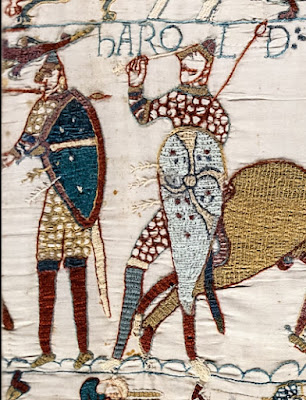1066 And All That
We all know about Harold Godwinson (King Harold) who got an eyeful at the Battle of Battle and was roundly defeated by Henry the Conqueror. It is all illustrated on the Bayeux Tapestry. Except that the picture isn't of King Harold, and doesn't show an arrow in the eye, according to modern research. But it makes a nice story!
Well, Mr Godwinson owned a lot of land to the North East of London, based round estates at Havering-atte-Bower, as in the London Borough of Havering. Hence the suburb of Harold Wood, a name which has existed since the 13th century.
Today we will find the community on the north-eastern edge of Greater London, close to the M25 on the other side of which border is Brentwood in Essex.
It was to be yet another Victorian suburb making oodles of money for its developers.
Harold Wood lay on the Great Eastern main line and in 1866, 300 acres of Gubbins farm was purchased by a group of developers who planned a new town there and contracted with the Great Eastern Railway for the building of a station in Gubbins Lane.
The station opened in February 1868.
The King Harold public house had been built ...... new roads laid out between the station and Colchester Road (A12) and the London Eastern District Land Co. had bought 40 acres of the estate, under covenant to build large villas worth not less than £1,000 each (£100,000 today)
Initially, travellers wishing to stop at Harold Wood Halt had to request from Romford or Brentwood, giving two days notice, or if they were on the train, jump off at Romford and inform the guard to stop at the Halt!
The original development soon petered out.
The big villas were not posh enough and smaller properties were too far from London, making "commuting" slow and expensive.
In 1877 the estate was bought by John Compton, who built the Grange ...
... as his own residence, and played the part of the local squire, while promoting further building, mainly to the south of the railway.
Harold Wood grew much more slowly than intended, however, and until the First World War remained hardly more than a village.
The map below, although dated nominally in the 1940s, shows little change from the inter-war years.

Once standing in its own "estate" in open country, and with a chequered history, this fine edifice, like The Grange and Haroldwood Hall, is now divided into genteel apartments.
One non-residential development is of importance in our on-going narrative. The grounds of The Grange, almost opposite Harold Wood station, were progressively developed as the vast Harold Wood Hospital. (click on the picture to enlarge it)
The Grange itself is just off the above diagram, to the right of the tower block ...
... which was the maternity wing. It all closed in 2006 leaving The Grange and the rest of the site ...... (seen above well before most of the modern hospital extensions were added) ready for developers. We are looking towards the railway with The Grange again missed off the shot to the left. But here is The Grange, boarded up and awaiting its fate.
fbb's 2016 London street atlas shows the area blank and not yet re-developed ...

... with the former hospital access road shown passing through buff anonymity.
Of course, the whole area has splurged significantly since WW2 with housing filling in north of the A12 and called Harold Hill.
Harold Wood station has recently had an upgrade with the usual new lifts and footbridge ...
... plus longer platforms and, possibly, a new and extra entrance.
Very smart.
It is, of course, all part of Not-Quite-Yet Crossrail.
Happily, the re-fettled station building upon the road bridge ...
... retains its pre-nationalisation heritage AND a pseudo gas lamp.
Very nice.
Just round the corner from the LNER labelled entrance we espy a sweet little Transport for London single decker.
So, inspired by a blog from Roger French, we will take a ride on the 497 (virtually) tomorrow.
Next Harould Would blog : Wednesday 6th October
























"Henry the Conqueror". FBB, you need to check your copy of "1066 and all that". Henry is generally better known as a vacuum cleaner.
ReplyDeleteIsn't Henry a Green Engine?
Delete